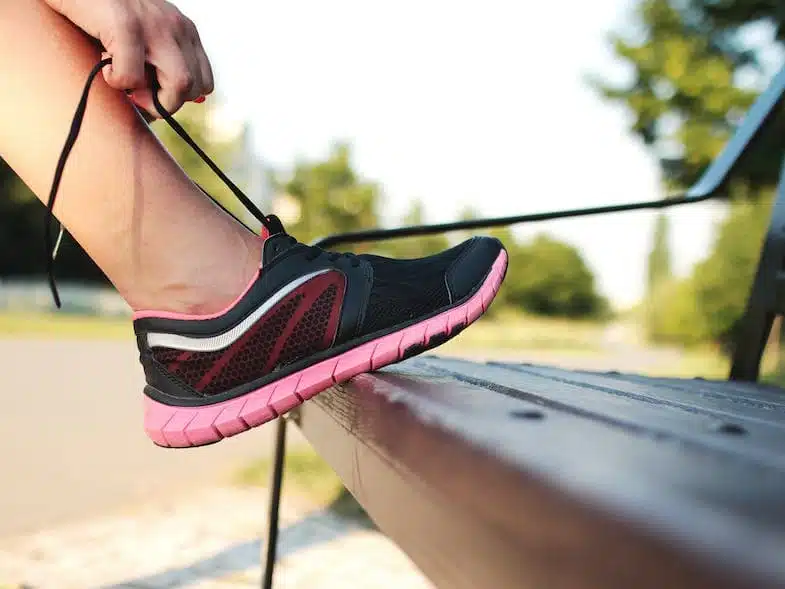Running: It’s the ultimate mood booster and stress reliever for millions. But what about postpartum running? Is lace up those shoes and hitting the pavement or trail safe after having a baby?
The short answer is yes, but with some very important caveats. While there may not be a one-size fits all prescription for postpartum exercise, understanding what’s happening inside your body along with a few key considerations can set you up for a successful return to running that supports, rather than hinders, pelvic health and recovery.
Table of Contents
ToggleWhen can you Start Postpartum Running?
Doctors typically clear new moms to begin exercising again around the 6-12 week mark post-delivery, advising to ease back into things gradually. And with good reason. Recovery from childbirth takes time whether you had a vaginal or cesarean delivery.
The body has its own timeframe for recuperating and this is especially true for the pelvic floor and abdominal muscles which endure tremendous strain during pregnancy and delivery. These muscles provide an important muscular foundation that stabilize and support us during pretty much every movement we make, from walking to exercising to playing with our kids.
Recent research indicates these muscles and other soft tissue structures continue healing past the 6-8 week point and remain far from their pre-pregnancy strength and stamina.
12 Weeks: A Good Marker
Most experts agree waiting until at least 12 weeks postpartum provides adequate time for rest and recovery before resuming higher impact activities like running. This timeline allows the body to rebound, helps minimize injury risk, and sets the stage for a successful return to exercise.
While some new moms may feel ready to lace up their shoes well before 12 weeks, it’s important to listen to your body and not ignore any warning signs indicating pelvic floor dysfunction or abdominal diastasis. Seeking assessment from a pelvic floor physical therapist can quickly determine if additional rehab is warranted before running.
Warning Signs Not to Ignore
Many well-meaning mothers eager to shed pregnancy weight quickly jump back into postpartum running before their bodies have fully healed. They often minimize or rationalize away subtle symptoms as “normal.” But leaking urine, pelvic pain, abdominal doming, and other issues are not normal. They signal underlying dysfunction requiring prompt attention.
Red flag symptoms to have evaluated before attempting postpartum running include:
- Leaking urine when running, jumping, laughing, sneezing or coughing
- Feeling heaviness, pressure or bulging in the pelvic region
- Pelvic discomfort or pain during/after intercourse
- Lower back pain
- Noticeable separation between rectus abdominis muscles (abdominal doming)
Ignoring these symptoms and pounding the pavement typically makes things worse. That’s why it’s so important new moms tune into their bodies, take things slowly, and prioritize healing during the initial 12 week postpartum period before attempting running.
Focus on Rest, Nutrition & Rebuilding Foundational Strength
The first 12 weeks after delivery should focus primarily on rest, nutrition, gentle movement, and rebuilding foundational strength in the pelvic floor and deep core muscles. Here’s how to make the most of this recovery phase:
Prioritize Sleep
Quality sleep often ranks last for time-crunched new moms. But ample sleep provides essential downtime for stressed muscles and soft tissues to heal. Aim for seven to nine hours per night. Nap when possible. If given the choice between exercise or sleep, choose sleep.
Hydrate, Hydrate, Hydrate
Proper hydration facilitates healing by transporting nutrients to recovering muscles and tissues. Drink at least 64 ounces (or more) of water daily. Add in nutrient-rich smoothies, bone broths, herbal teas to further support the healing process.
Eat Nutrient-Dense Foods
Quality nutrition provides the building blocks for repairing strained muscles and soft tissues. Emphasize plenty of anti-inflammatory foods like fatty fish, colorful vegetables, berries, nuts and seeds. Avoid highly processed foods and added sugars. These increase inflammation, disrupt gut health and impair healing.
Move Your Body Gently
While rest is vital initially, gentle movement as you’re able also aids the healing process by increasing blood flow to recovering tissues. Low impact activities like walking, swimming or prenatal yoga help rebuild foundational strength without overtaxing the body.
Activate Your Pelvic Floor
The pelvic floor directly supports organs and muscles inside the pelvis. Learning to properly contract this muscular web by drawing muscles up and in strengthens muscle fibers and enhances coordination.
Try performing 10 slow, gentle pelvic floor lifts lying down, sitting or standing several times per day. Use diaphragmatic breathing to relax the pelvic floor on the inhale and consciously contract on the exhale. Progress reps as able.
Reconnect With Your Core
The deep inner core unit provides stabilization and structural support that enables proper running mechanics. Reestablishing mind-body connection begins with simple exercises done lying down:
- Draw belly button towards spine feeling a gentle lift inside the pelvis
- Perform gentle heel slides while maintaining core activation
- Progress to bent knee drops with activation
- Move to sitting then standing core activation
Mastering basic core and pelvic floor activation establishes an essential foundation for returning to running without leakage or discomfort.
Walk It Out
Once initial healing progresses, gently increase activity tolerance by taking short, easy walks outside. Soak in some mood-boosting sunlight and fresh air. Gradually increase duration and intensity. Listen carefully to your body for fatigue.
Build up to more brisk walking or hiking on an incline treadmill around weeks 6-8 but go slowly and stop immediately if any discomfort arises. Focus on maintaining proper alignment and core/pelvic floor activation throughout.
Incorporate Total Body Moves
At 2-4 weeks postpartum when your body feels ready, begin adding some gentle bodyweight strength moves like squats, lunges, and push-ups paying special attention to core engagement and pelvic stability.
Around weeks 6-8, light strength training can progress to include moves like planks, bridges, chest presses using minimal hand weights. Move slowly. The goal is controlled strengthening NOT grinding out high reps which can overload healing tissues.
Gradually Resume Running after 12 Weeks
Once 12 weeks have passed and you’ve realistically dedicated time to rest, nutrition and rebuilding foundational strength as outlined above, you stand the best chance of bouncing back to postpartum running without issues.
Keep in mind, every woman’s delivery and recovery differs so don’t compare yourself to others. Rehabilitation needs vary greatly. An individualized approach works best guided by how you feel along with feedback from pelvic floor physical therapy assessment.
When given the final green light to run, take things very gradually. Here are some suggested guidelines for ramping up safely:
- Week 1: Warm up by walking 5 minutes then try jogging 30-60 seconds at 50% intensity followed by 1 minute of walking recovery x 6-8 intervals. Repeat every other day. Stop immediately if any pain.
- Week 2: Warm up then jog 60 seconds at 50% intensity with 1 minute walk recovery x 6-10 intervals. Try increasing jog time and lowering walk time. Repeat every other day.
- Week 3: Warm up then jog 90 seconds at 50-70% intensity with 30 seconds walk recovery 6-10 intervals. Can repeat session other days if no lingering muscle soreness.
- Week 4: Warm up then jog 2 minutes at 70% intensity with 30 seconds walk recovery x 6-10 intervals. Repeat sessions every 2-3 days.
Continue gradually building volume, intensity and frequency from here on an individual basis guided by how your body responds. Don’t increase more than 10% weekly volume to avoid overtraining. Closely monitor for any pelvic/abdominal symptoms and stop immediately if any arise. Consider scheduling a tune up with pelvic PT around 6 months postpartum.
Postpartum running - Listen to your Body
The bottom line is every woman’s body rebounds differently after giving birth. Some bounce back quickly while others require extended rehab. That’s why it’s so important to tune into subtle signs from your body instead of blindly following some rigid exercise prescription.
Patience and gradually ramping up activity based on your unique timeframe stand the best chance for success. Don’t compare yourself to pre-baby fitness levels or where your bestie or neighbor is at with running. Celebrate and respect your body for the miracle it performed growing and birthing new life!
With adequate rest and healing early on combined with a slow build up guided by how you feel and backed by pelvic floor expertise, chances are good for getting back to running without leakage, discomfort or strain. Here’s to happy healing on your postpartum running journey!



